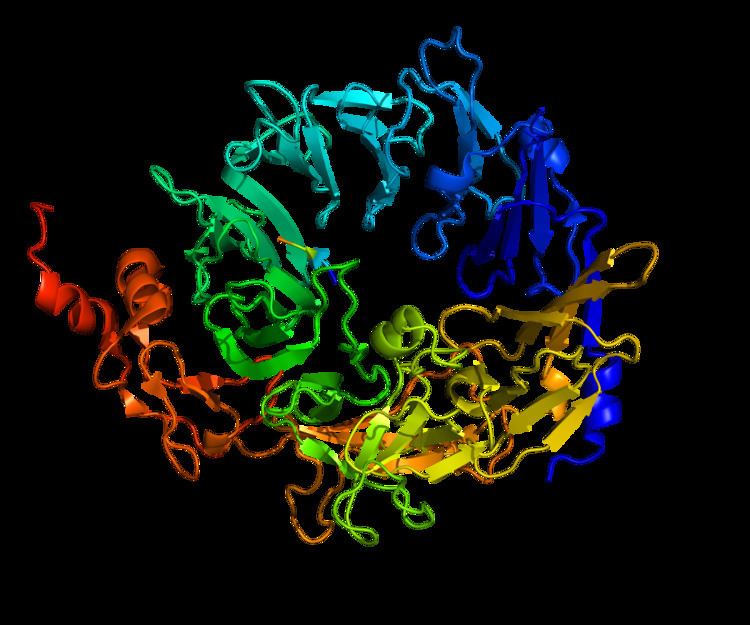Entrez 6272 | Ensembl ENSG00000134243 | |
 | ||
Aliases SORT1, Gp95, LDLCQ6, NT3, NTR3, Sortilin 1 External IDs MGI: 1338015 HomoloGene: 136097 GeneCards: SORT1 | ||
Sortilin (SORT1) is a protein that in humans is encoded by the SORT1 gene on chromosome 1. This protein is a type I membrane glycoprotein in the vacuolar protein sorting 10 protein (Vps10p) family of sorting receptors. While it is ubiquitously expressed in many tissues, sortilin is most abundant in the central nervous system. At the cellular level, sortilin functions in protein transport between the Golgi apparatus, endosome, lysosome, and plasma membrane, leading to its involvement in multiple biological processes such as glucose and lipid metabolism as well as neural development and cell death. Moreover, the function and role of sortilin is now emerging in several major human diseases such as atherosclerosis and coronary artery disease, Alzheimer’s disease, and cancer. The SORT1 gene also contains one of 27 loci associated with increased risk of coronary artery disease.
Contents
Gene
The SORT1 gene resides on chromosome 1 at the band 1p13.3 and includes 23 exons. This gene encodes 2 isoforms through alternative splicing.
Protein
Sortilin is a member of the Vps10p sorting receptor family. Crystallization studies of the protein reveal that, when complexed with the ligand neurotensin, the Vps10 ectodomain of sortilin forms a ten-bladed beta-propeller structure with an inner tunnel that contains multiple ligand binding sites. To prevent premature ligand binding during its synthesis, the precursor protein of sortilin contains a 44-amino acid pro-peptide that serves as a chaperone for the Vps10p domain. In addition, two hydrophobic loops have been detected in this domain and act to anchor the protein in the cell membrane.
Function
In humans, sortilin is expressed over a wide range of cell types and tissues such as the brain, spinal cord, adrenal gland, thyroid, B-lymphocytes, adipocytes, skeletal muscle, and heart. As a sorting receptor on the cell surface and on the endoplasmic reticulum-Golgi apparatus within the cell, sortilin is involved in the transport of a wide variety of intracellular proteins between the trans-Golgi network, endosome, lysosome, and secretory granules, as well as the plasma membrane. This molecular function enables sortilin to participate in various biological processes, including the transport of GLUT4 to the plasma membrane of fat and skeletal muscle cells in response to insulin. It also mediates the interaction between proNGF and the p75NTR:sortilin complex by acting as a co-receptor to signal cell death. The fine regulation of the brain-derived neurotrophic factor (BDNF) by sortilin is required for both neuronal and tumor cell survival. Moreover, sortilin has been implicated in LDL-cholesterol metabolism, VLDL secretion, and PCSK9 secretion, and thus plays a role in the development of atherosclerotic lesions. Other processes involving sortilin include endocytosis, negative regulation of lipoprotein lipase activity, myotube differentiation, ossification, and regulation of gene expression.
Clinical Significance
Given its function in facilitating lysosomal degradation or recycling of ligands in lipid metabolism and the neural system, sortilin likely plays an important role in the underlying mechanisms and pathophysiology of atherogenesis and coronary artery disease, as well as in neurological disorders. For example, sortilin has been identified as an important receptor for brain apolipoprotein E (APOE) metabolism, which is implicated in the underlying mechanisms of Alzheimer’s disease. Interestingly, a significant role for sortilin has recently also been reported in the field of oncology, as it has been detected in several cancer cell lines. Notably, human cancerous epithelial cells exhibited increased levels of sortilin as compared to normal epithelial tissues. Furthermore, it appears that sortilin participates in the progression of breast cancer and contributes to tumor cell adhesion and invasion.
Clinical Marker
In 2007, chromosome 1p13.3 was identified as a promising locus through a genome-wide approach in patients with coronary artery disease. Subsequently, accumulating evidence suggests that the SORT1 gene at the 1p13 locus is an important risk factor for coronary artery disease, which is attributed to lipid metabolism disorders. As the role of sortilin in lipid metabolism and the development of atherosclerosis has been established, a recent study further reported that increased release of soluble sortilin from platelets, measured as circulating sortilin, may be associated with in vivo platelet activation. This observation also indicates that sortilin has a potential application as a clinical biomarker for diagnosis and prognosis. Additionally, a multi-locus genetic risk score study, based on a combination of 27 loci including the SORT1 gene, identified individuals at increased risk for both incident and recurrent coronary artery disease events, as well as an enhanced clinical benefit from statin therapy. The study was based on a community cohort study (the Malmo Diet and Cancer study) and four additional randomized controlled trials of primary prevention cohorts (JUPITER and ASCOT) and secondary prevention cohorts (CARE and PROVE IT-TIMI 22).
Interactions
Sortilin has been shown to interact with GGA1 and GGA2.
Interactive Pathway Map
Sortilin participates in interactions within the trans-Golgi network vesicle budding and BDNF signaling pathways.
